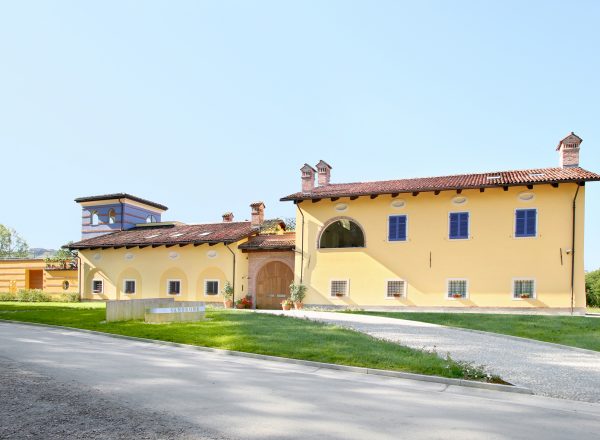
Sandrone
Barbera d’Alba 2020
Barbera d'Alba
Barbera is a delicate and demanding grape varietal. A meticulous search throughout the area for the very best soils, agronomical decisions and particular attention to vinification enable Sandrone to reveal the very best qualities of this wine. Barbera d’Alba is made to be a medium-weight wine that will drink well for a decade. It shows delicious and plump berry and black fruits. As Barbera possesses almost no natural tannins, the use of tonneaux gives the wine some much-needed structure. It is a perfect match with rich winter dishes as the bright acidity keeps it from being too heavy.
VINEYARD

The Sandrone Barbera d’Alba comes from three vineyards: Merli and Rocche di San Nicola in Novello, and Cascina Pe Mol in Monforte d’Alba. The Sandrone section of the Merli is a south-southwest facing bowl that catches the afternoon light perfectly. The wines made from here are earthy and robust, but with good aromatic complexity. Rocche di San Nicola is an extremely steep vineyard at the very end of the Novello promontory, just above the tall clay cliffs that plunge down to the streambed that flows toward Monchiero. It receives incredible sun and heat and is almost constantly breezy; it is thus perfectly situated for Barbera, which thrives in these conditions. The crumbling farmhouse (cascina) of Pe Mol sits at the top of the ridge leading from Monforte d’Alba to the hamlet of Perno and is among the highest vineyards in the region. Because it sits at the top of the ridge, it is unsuitable for Nebbiolo, a fickle plant which abhors windy conditions. At the top of the ridge, Barbera thrives, and slightly down the slope are excellent plantings of Dolcetto. From this lofty perch one can see the Monte Bianco, the Monte Rosa and the Cervino on a clear day (Mont Blanc, Monte Rosa and the Matterhorn, respectively).
WINEMAKING

Each vineyard is vinified separately. After destemming and light crushing, the must is covered with CO2 for a gentle warm maceration of approximately a day. Alcoholic fermentation begins about 24-36 hours later from native yeasts. A gentle maceration takes place in upright open-top steel tanks for the first 8-10 days of alcoholic fermentation. Immediately after alcoholic fermentation, which takes around 20 days, malolactic fermentation takes place in 500 liter French oak casks. The wine is aged in these casks for 12 months, followed by 9 months bottle aging. Around 1,800 cases are produced in a typical vintage.
VINTAGE

2020 will be remembered as a year of long, alternating periods of heat and cool, giving rise to a wine that is characterized by both.
The year began with a mild, dry winter with few truly cold days. While January was mostly sunny some snow and rain finally arrived in mid-February. The end of February saw a rise in temperatures indicative of a precocious spring.
Early March brought continued good weather, unseasonably warm and dry, and we rushed to finish the winter work. By mid-March, the weather had cooled considerably, and the rate of vegetative growth slowed significantly.
In April, weather patterns were established that continued nearly the whole growing season: 4-5 days of brilliantly sunny days, followed by 1-2 days of rain. This gave plenty of water to the plants but complicated the treatments schedule. The extra humidity brought on serious infections of Peronospora in the region. Luca’s long experience allowed us to keep ahead of the disease and we saw no significant damage in 2020. Flowering in late May was under favourable conditions and brought a good crop set.
Some real heat arrived at the end of July but was mitigated by the continuing sun-rain pattern and the deep groundwater reserves that had built up. Warm weather continued until mid-September, when a series of thunderstorms cooled off the region. The next few weeks were exemplary, with bright, sunny days and crisp, cool nights. The harvest was easy and the fruit ripened evenly.
The harvest took place from September 23rd until 28th.
TASTING NOTE

This is THE typical Barbera d’Alba wine. Ripe, spicy black fruit nose with deep oak, framing a core of pure black berries and plums along with a very deep purple-black color.
In the mouth, the wine is all dark fruits. This shows blackberries and raspberries, with a chocolate and cocoa powder midpalate and hints of cassis.
Concentrated, generous and mouth-filling. The high natural acidity of Barbera gives freshness and balance to the exuberant fruit.
The chewy mid-palate gives this wine excellent flexibility at the table, and the typical acidity of Barbera shines through to give the vine a vibrant, bright and long finish.
Color
Red
Appellation
Barbera d'Alba
Farming
Follows organic farming but has chosen not to seek certification. Minimal quantities of Bordeaux mixture and sulfur (as allowed per organic practices) are used to control mold and fungus, and fertilization every 4-6 years occurs with composted manure from dairy cows.
Alcohol
13.5%
Suggested Retail Price
$43.00
Reviews
"An absolute delight"

Vinous - December 8, 2022 "The 2020 Barbera d'Alba is another wine that shows the greater refinement at Sandrone these days. Even so, there's plenty of richness in the ripe red cherry, plum, mocha and spice flavors. Soft, silky contours wrap it all together, with a gentle kiss of oak that lingers. The 2020 is an absolute delight." -A.G 11/22

Wine Enthusiast - January 16, 2023 "Sandrone brings its care and dedication to this big, bold and beautiful Barbera. The wine begins with aromas of spiced black plums, black cherry jam and savory herbs. The palate is very rich with flavors of roasted blackberry, smoked meats and savory herbs. Firm tannins and classic Barbera acidity will allow this wine to age well." —J.P. 2/2023
"Dark and blue fruit"

James Suckling - July 6, 2023 "This is very attractive with fresh dark and blue fruit together with hints of violets, dried citrus peel and cocoa, following through a medium-bodied, textured and sleek palate with crunchy acidity and vibrant juiciness to the fruit. " —J.S. 7/2023
Trade Materials
Other Wines by this Producer

Dolcetto d’Alba
Dolcetto d'Alba
Sandrone's Dolcetto d’Alba is produced using Dolcetto grapes from 11 different vineyards, all within the Barolo DOCG. Sandrone’s Dolcetto sees no time in wood and is a remarkably robust and complex example of the variety.

Le Vigne Barolo
Barolo
Le Vigne is a wine created from four different Nebbiolo vineyards, each of which brings its own contribution. This union generates an exceptionally complex wine that is round and harmonious on the palate, with fruity and spicy notes, and this approach of blending together plots is in fact the traditional one in Barolo.

Valmaggiore
Nebbiolo d'Alba
Valmaggiore is the product of Luciano’s incredible passion for the Nebbiolo grape variety and its different expression. Just 15 miles away from Barolo, in the Roero region, Nebbiolo produces a lighter structure and ripe, smooth tannins that are not unlike those of Pinot Noir. This is not a “baby Barolo” or a second wine at all – it is a distinct interpretation of Nebbiolo from a completely distinct geographic zone.

ALESTE Barolo
Barolo
A combination of the names of Luciano Sandrone's grandchildren ALEssia and STEfano, ALESTE is the new name for Luciano's first wine, the Barolo Cannubi Boschis, which garnered early acclaim with the international trade and press. This single-vineyard wine is typically dense and concentrated, but shows incredible harmony and balance.











